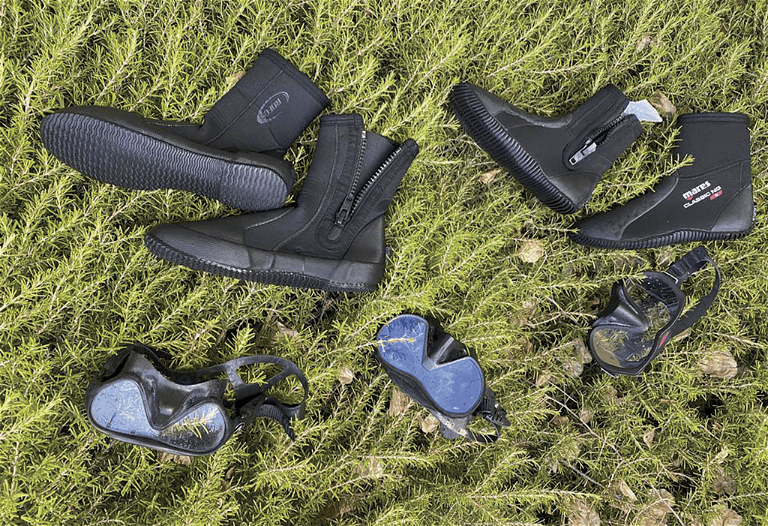Tim Blömeke offers some handy hints and advice for the travelling diver.
Dive trips are supposed to be fun and relaxing. Hauling lots of heavy equipment, on the other hand, tends to be the opposite of that – it can be expensive, time-consuming and stressful.
Dive equipment and airline travel don’t mix well. While innovations in materials and design have led to lighter and more packable gear, some products marketed as ‘travel versions’ may not be as comfortable, durable or easy to use as standard gear.
Deciding which pieces of equipment to bring and which (if any) to rent at the destination is a question many of us struggle with before every trip. While most rental gear available at popular diving destinations is adequate, it just feels better to use equipment you’re familiar with. Also, there are a few essential pieces of kit that you’ll definitely want to bring from home.
Here are some considerations for travelling with (or without) various pieces of dive equipment.
Buoyancy Control Device
Whether you choose to travel with your buoyancy control device (BCD) or rent one may come down to how much you like diving with yours. While the BCD is an important part of your kit, it can also be relatively large and bulky. You can make a case for either packing your own or renting one. Minimalist jacket-style or back-inflate BCDs with small bladders are available, as are harnesses with aluminium or even carbon-fibre backplates and small wings for divers who don’t need a lot of features.
Regulators
Regulators are important life support equipment, and many divers prefer to travel with their own, for ease of breathing and for hygiene reasons. Many manufacturers offer compact and lightweight regulators for travel, sometimes using materials such as titanium and carbon fibre.
If you’re diving with your own air-integrated computer, you can remove your regulator’s analog pressure gauge to further reduce weight.
A good way to ensure hygiene even if you don’t own or don’t want to carry a regulator is to bring a personal mouthpiece and ask the dive centre or resort to attach it to a rental regulator.
Dive computer
Aside from a mask, a dive computer is usually at the top of the list of things divers will carry even when travelling light. Familiarity with your dive computer promotes both comfort and safety while diving. A wrist-worn computer that links to your regulator via a transmitter can be an enjoyable and space-saving investment, and the more compact ones can serve as your watch for the duration of the trip.
Mask
As your window to the underwater world, your mask is critically important. If you own one that’s comfortable, offers good visibility and doesn’t leak or fog, take it with you wherever you go. Be sure to protect your mask; carefully pack it, and keep it in its case when you aren’t using it. Many comfortable low-volume and frameless masks are available that take up less space and may be less likely to break if your luggage is dropped or crushed. And even on nondiving days, a mask is still good for snorkelling.
Fins
A set of fins can range in weight from less than 1kg to over 4kg. Most diving in warm-water destinations can be done with a lightweight full-foot fin, with or without a neoprene sock to protect your foot. These fins are often easier to pack than their open-heeled counterparts, and you won’t have to bring your wetsuit boots to use them.
Exposure protection
Wetsuits and drysuits can be both heavy and bulky. But a thin one-piece wetsuit or trilaminate drysuit can be tightly rolled or folded and stored with your clothes; bringing your own suit ensures fit and comfort and reduces hygiene concerns. Most dive shops have exposure protection that is appropriate for the location available for rent, and it might be cheaper and easier to rent a suit than to pay fees for extra luggage. When planning to rent, it may be a good idea to bring your own skin suit to wear under a rental wetsuit.
Surface marker buoy and signal mirror
Although it’s possible to dive without a surface marker buoy (SMB) and a signal mirror, you really shouldn’t. However, very few dive shops offer these tools as rental gear, so you’ll want to bring your own. If you are separated from your boat or forced to surface in an unexpected place, or if you just need to quickly get someone’s attention, these items can be actual lifesavers. To be certain you can effectively use these tools if in distress, be sure to practise with them on training dives.
Dive light
Shining a light during a deep or dusk dive brings to life the colours of the local flora and fauna and illuminates cracks and crevices of the reef or wreck that might have been invisible otherwise. Lights are usually quite expensive to rent relative to their price, and they’re compact and easy to carry – excellent reasons to bring one with you on your trip. Confirm airline and transportation authority policies concerning batteries before you fly.
Cutting tool
This is another recommendation that should really be a requirement. You don’t need to strap a big honking dagger to your leg to be a safe diver. A lightweight line-cutter or even a pair of medical shears take up very little space and usually do a much better job in most situations you are likely to encounter.
Save-a-Dive Kit
Extra O-rings, fin and mask straps, blocking plugs for the first stage and a back-up dive computer or pressure gauge are nice to have in a pinch. If your destination won’t have equipment for you to use if yours fails, consider bringing spare parts or a backup. Don’t go overboard though – remember, we’re travelling light.
Camera
If your camera is small enough that it doesn’t need its own piece of luggage, consider wearing it around your neck or on your shoulder as a carry-on. This will keep you from having to check it at the airport and will prevent it from getting jostled or damaged.
Summary
Think small while you pack, and bring just the basics. Mask, computer, torch, cutting tool, and DSMB are all exceedingly useful to have while being compact and easy to carry. Call local dive shops before you travel to check on rental-gear availability — anearby shop might be able to provide just about everything you need. If not, get creative. Except for the exposure suit and the line cutter, you could probably fit everything on this list into a carry-on backpack if you packed it just right. And besides, how many changes of clothes do you really need?
DAN Membership
Before leaving make sure your DAN membership is still active. If it isn’t, join DAN or renew your membership at Dan europe.
Your DAN membership ensures the services of the biggest international network for assisting divers anywhere, during any emergency.
This article was originally published in Scuba Diver UK #75.
Subscribe digitally and read more great stories like this from anywhere in the world in a mobile-friendly format. Link to the article








